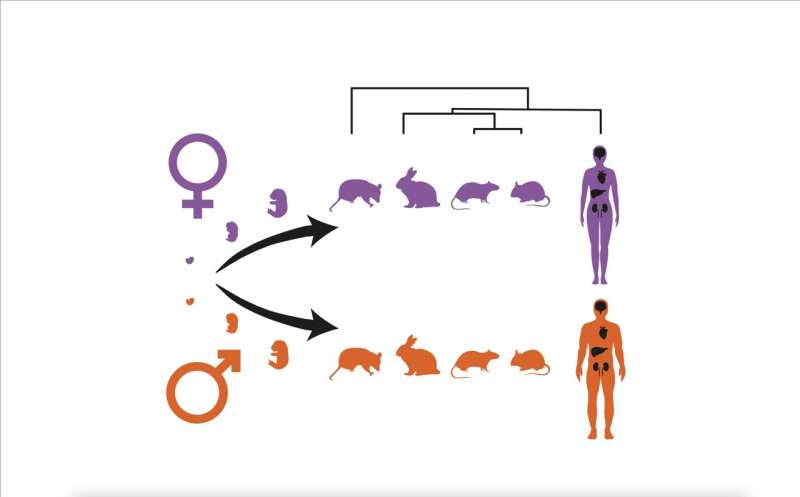This article has been reviewed according to Science X's editorial process and policies. Editors have highlighted the following attributes while ensuring the content's credibility:
fact-checked
peer-reviewed publication
trusted source
proofread
How organs of male and female mammals differ

The development of sex-specific characteristics is frequently seen in mammals. These characteristics stem from the activation of corresponding genetic programs that until now have been largely undescribed by the scientific community.
An international research team from the Center for Molecular Biology of Heidelberg University and The Francis Crick Institute in London has, for the first time, decoded the programs that control the sex-specific development of major organs in selected mammals—humans, mice, rats, rabbits, and opossums. By comparing these programs, the researchers were also able to trace the evolution of sex-specific organ characteristics.
Sexual dimorphism describes the development of secondary sex characteristics and in biology refers to the differences in the appearance of sexually mature males and females of the same species that are unrelated to the reproductive organs.
Such sex-specific characteristics include clearly identifiable differences in the size and coloration of the body, or the development of different organs, such as antlers in male deer. In addition, there are less obvious differences in terms of the size, function, and cellular composition of internal organs.
In humans, these differences, in the liver for example, can lead to sex-specific processing or efficacy of medications, according to Prof. Dr. Henrik Kaessmann from the Center for Molecular Biology of Heidelberg University (ZMBH), who led the work together with Dr. Margarida Cardoso-Moreira of The Francis Crick Institute in London.
The development of mammalian organs before and after birth is controlled by the finely tuned and complex interaction of many different genes—also known as gene expression programs.
"Overall, this development-related gene expression is fairly well understood, among other things through the work in our lab. Until now, however, what was largely unknown was how these programs differ between female and male individuals and the effects these differences have on the function and cellular composition of organs in adult mammals," explains Leticia Rodríguez-Montes, a doctoral candidate in Prof. Kaessmann's "Evolution of the mammalian genome" research group.
The researchers in Heidelberg and London finally succeeded in systematically mapping the genes at the organ and cellular level that are primarily active in only one of the two sexes during development and therefore lead to the formation of different organ characteristics in female and male individuals.
On the basis of sequencing data and by applying bioinformatic analysis methods, the researchers discovered a surprising pattern that applies to all the mammals they studied: "Almost all of the differences in gene expression abruptly develop only in puberty. That means that the genetic programs responsible for the development of sex-specific organ characteristics are turned on almost exclusively late in the development of the organs, triggered by female or male hormones," states Prof. Kaessmann.
To also understand the evolution of these gene regulatory programs, the researchers compared their results for the various mammals in detail.
"In most species we studied, the liver and kidneys exhibit numerous differences in gene expression between the sexes, which in turn lead to marked sex-specific differences in the functionality of these organs," explains Dr. Cardoso-Moreira. The researchers further learned that these differences between the sexes occur across mammals in the same organs and the same cell types in these organs; but they mostly occur through the activity of different genes.
The current findings illustrate the rapid evolution of sex-specific characteristics, which according to Leticia Rodríguez-Montes are probably due to different challenges during speciation. "One exception are the few genes found on X and Y sex chromosomes that presumably function as basic genetic triggers for the development of sex-specific characteristics in all mammals," explains the researcher.
The results were published in the journal Science.
More information: Leticia Rodríguez-Montes et al, Sex-biased gene expression across mammalian organ development and evolution, Science (2023). DOI: 10.1126/science.adf1046. www.science.org/doi/10.1126/science.adf1046





















